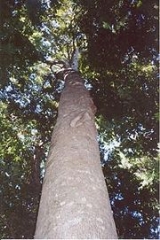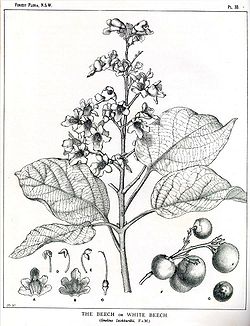
Gmelina leichhardtii
Encyclopedia
- "White Beech" redirects here. This may also refer to the related Gmelina arboreaGmelina arboreaGmelina arborea, , locally known as Gamhar, is a fast growing deciduous tree, occurring naturally throughout greater part of India at altitudes up to 1500 meters...
, especially outside Australia.
Gmelina leichhardtii, the White Beech is a rainforest tree of eastern Australia
Australia
Australia , officially the Commonwealth of Australia, is a country in the Southern Hemisphere comprising the mainland of the Australian continent, the island of Tasmania, and numerous smaller islands in the Indian and Pacific Oceans. It is the world's sixth-largest country by total area...
. Scattered individuals or small groups of trees naturally occur from the Illawarra
Illawarra
Illawarra is a region in the Australian state of New South Wales. It is a coastal region situated immediately south of Sydney and north of the Shoalhaven or South Coast region. It encompasses the cities of Wollongong, Shellharbour, Shoalhaven and the town of Kiama. The central region contains Lake...
district of New South Wales
New South Wales
New South Wales is a state of :Australia, located in the east of the country. It is bordered by Queensland, Victoria and South Australia to the north, south and west respectively. To the east, the state is bordered by the Tasman Sea, which forms part of the Pacific Ocean. New South Wales...
(34½° S) to near Proserpine
Proserpine, Queensland
-External links:* * * * *...
in tropical Queensland
Queensland
Queensland is a state of Australia, occupying the north-eastern section of the mainland continent. It is bordered by the Northern Territory, South Australia and New South Wales to the west, south-west and south respectively. To the east, Queensland is bordered by the Coral Sea and Pacific Ocean...
. The White Beech or Grey Teak is a fast growing tree, growing on volcanic and alluvial soils in areas of moderate to high rainfall. It also grows on poorer sedimentary soils in fire free areas. White Beech may occasionally be seen in Australian rainforests, their status is considered "uncommon". Unlike the Australian Red Cedar, the White Beech has not recovered particularly well after logging in the 19th and 20th centuries.
Illawarra
White Beech is rare and endangered in the IllawarraIllawarra
Illawarra is a region in the Australian state of New South Wales. It is a coastal region situated immediately south of Sydney and north of the Shoalhaven or South Coast region. It encompasses the cities of Wollongong, Shellharbour, Shoalhaven and the town of Kiama. The central region contains Lake...
region. It is likely that less than one hundred trees remain in some thirty different sites in the Illawarra. The locality of Broughtonvale (34½° S), near Berry, New South Wales
Berry, New South Wales
Berry is a small Australian town in the Shoalhaven region of the NSW South Coast in the state of New South Wales, located south of the state capital, Sydney. The indigenous people of the area were the Wodi Wodi people. In the 1810s, George William Evans, Government Surveyor, reported on the Berry...
is considered by Anders Bofeldt as the southern limit of natural distribution. However, D.J. Boland considers the far more southerly Clyde River, New South Wales (35° S) near Batemans Bay to be the southern limit of distribution. White Beech trees in the Illawarra
Illawarra
Illawarra is a region in the Australian state of New South Wales. It is a coastal region situated immediately south of Sydney and north of the Shoalhaven or South Coast region. It encompasses the cities of Wollongong, Shellharbour, Shoalhaven and the town of Kiama. The central region contains Lake...
may be seen by the Minnamurra Falls rainforest walk in Budderoo National Park
Budderoo National Park
Budderoo is a national park in New South Wales, Australia, 99 km southwest of Sydney, best known for the timber boardwalk through the Minnamurra rainforest...
, however, these trees are not signposted.
Description
Mature specimens reach 15 to 30 metres tall, though exceptional individuals can reach 60 metres tall, and live for centuries. The base of the largest trees exceeds two and a half metres in diameter. The bark is grey, and the trunk is cylindrical with a flanged but not buttressed base. Considered by some to be a semi-deciduous species, losing part of the canopy in late spring. Green leaves are almost always found at the base of the tree, assisting with tree identification.Branchlets are thick, grey or brown and hairy. Leaf scars prominent. Young shoots are densely velvety and hairy.
The mature leaves are pale green and ovate, 8 to 18 mm long. Hairy and veiny on the underside. Midrib, lateral and net veins distinct on the upper surface, conspicuously raised and distinct beneath due to the covering of fawn hairs. Lateral veins eight to ten, straight and forking near the margin at 45 degrees to the midrib. Juvenile leaves are toothed. Purple, yellow and white flowers form in late spring and summer.

Germination
Around Easter time, seeds mature within a fleshy bluish or purple drupeDrupe
In botany, a drupe is a fruit in which an outer fleshy part surrounds a shell of hardened endocarp with a seed inside. These fruits develop from a single carpel, and mostly from flowers with superior ovaries...
2 to 3 centimetres in diameter. These are eaten by the Wompoo Fruit Dove, Paradise Riflebird
Paradise Riflebird
The Paradise Riflebird, Ptiloris paradiseus, is a medium-sized, up to 30 cm long, passerine bird of the Paradisaeidae family. The male is black with an iridescent greenish blue crown, throat and central tail feathers. It has a black curved bill, black feet, dark brown iris and yellow mouth...
, Topknot Pigeon
Topknot Pigeon
The Topknot Pigeon is a pigeon native to Australia. It is also known by the name of "Flock Pigeon".-Description:...
and possibly other large fruit eating birds. The fruit contains a hard wooden capsule. The capsule contains four cells, each with a viable or non viable seed.
The fleshy aril
Aril
An aril is any specialized outgrowth from the funiculus that covers or is attached to the seed. It is sometimes applied to any appendage or thickening of the seed coat in flowering plants, such as the edible parts of the mangosteen and pomegranate fruit, the mace of the nutmeg seed, or the...
needs to be removed, as it contains agents which inhibit seed germination. Regular watering and drying of the capsules seems to improve germination results. Germination is slow and unreliable, taking between six months and four years. Seedlings usually appear in late spring and summer.
A successful technique for germinating White Beech is to collect new purple fruit. Cut off the fleshy aril
Aril
An aril is any specialized outgrowth from the funiculus that covers or is attached to the seed. It is sometimes applied to any appendage or thickening of the seed coat in flowering plants, such as the edible parts of the mangosteen and pomegranate fruit, the mace of the nutmeg seed, or the...
. Place the wooden "nut" in the sun for a few days. When cracks appear around the emerging seed compartments. Place it in a large container. Ensure the capsule receives adequate moisture and warmth in the cooler months. Trying to open the hard nut in the middle of the fruit, or hitting the capsule with a hammer has proven useless. The best technique appears to be the removal of the outer blue/purple flesh. Then exposing the inner capsule to sunlight and moisture. The sunlight cracks the outer covering of the capsule. The moisture seeps through the outer shell, affecting the inner seed. When the seed is germinated, it pushes open the cells of the capsule. The majority of capsules will not produce seedlings. A large quantity of capsules is advised for propagation.

